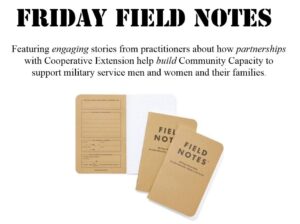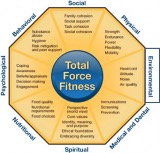
Welcome back to Friday Field Notes! Last week, we explored how nature-based recreation is helpful for all humans regardless of cultural background, but also how culture affects access to such recreation. This week, we’ll focus specifically on military service members and the benefits of increasing contact with nature.

History of Nature-Based Recreation
Nature-based recreation is not a new concept. Though it has been called by many names in the past – wilderness therapy, outdoor behavioral health, ecotherapy – the concept is still the same.
According to the American Horticultural Therapy Association, the practice has been documented since ancient times. Following World War I, horticultural therapy was expanded to treat traumatized soldiers returning from combat. Since then, the art and practice has been accepted as a credible treatment option for a wide range of diagnoses of all severity.
Though horticultural therapy is primarily associated with therapeutic gardens, the benefits of spending time in nature are transferable to many settings.
Benefits for All
Nature-based therapy originated with the intent of helping troubled adolescents, but with such positive effects the treatment modality has quickly expanded to include cohorts of all ages.
A large body of research on nature-based recreation points to positive benefits for almost anyone. According to Hoag et al. (2013), outdoor behavioral health provides an effective alternative to rehabilitation programs for individuals with substance use disorders. It also provides an effective alternative to psychiatric hospitalization for those with mood or interpersonal difficulties.
The researchers conducted a study in southwest Utah with 297 young adults to investigate the efficacy of wilderness therapy over 3 years. The results were astounding! Participants reported significant changes in sense of life effectiveness, dysfunctional attitudes, alliance with his/her therapist, motivation for therapy, mood, interpersonal relationships, social skills, behavioral difficulties, life skills, and their desire to change. They also reported decreased cognitive distortions.

Humans are not the only ones to benefit from nature-based activities either. The environment greatly benefits from it as well.
According to Tidball and Aktipis (2018), individuals become more willing to engage in greening (engagement in local ecological investment) as a result of observing greened environments and observing individuals engaging in greening (i.e., planting trees and recycling). This social-ecological feedback contributed to the recovery of certain neighborhoods in New Orleans after Hurricane Katrina.
Veterans with PTSD
Individuals who have been diagnosed with PTSD report struggling with social problems such as substance abuse as well as more general health problems and utilization of medical services (David et al., 2004). Poulsen et al. (2016) at the University of Copenhagen conducted a study in 2016 to study 8 veterans with PTSD in the university’s forest therapy garden.
The environment was chosen based on the fact that soldiers have an existing relationship with the environment. Being in combat means fighting and surviving in nature. For this reason, it was important to understand the veterans’ existing relationship with the environment.
The study took place over 10 weeks with a follow-up interview 1 year later. Components of the nature-based therapy included mindfulness activities like deep breathing and yoga exercises, nature-based activities (i.e., bird watching, learning about plants, or chopping firewood) at whatever comfort level the participants preferred, and weekly individual therapy sessions that were focused on problem-solving and conflict resolution.

Throughout the 10 weeks, positive progress was noted by participants going from choosing sheltered places in the garden to choosing more open spaces for their activities and even welcoming the company of fellow veterans. Results showed that even at the 1-year follow-up interview, nature still had a major influence on the veterans’ lives. Some participants actively sought nature in their everyday lives for inner peace and problem-solving. However, for some veterans with more severe PTSD symptoms, leaving home to spend time in nature was nearly impossible. Nonetheless, they aspired to spend time in nature.
Implications for Practitioners and Service Members
- Participants were encouraged to listen to their own needs and did not feel pressured to share difficult memories.
Veterans in the study were not pressured to share painful memories of war, or to participate in more rigorous activities than they felt that they could handle. Activities chosen by the veterans were fully supported by staff, increasing their sense of autonomy. - The nature setting provided an environment with low demands and little directed attention.
Soldiers are accustomed to being in environments that place high demands on them and require high levels of directed attention in order to survive. Nature-based activities, on the other hand, required nothing of the participants.In the words of one veteran:
“Nature is special because there are no demands and expectations to you. Well, there is a tree, and I am sitting here, no expectations, no questions, no nothing.”
- Veterans experienced a sense of accomplishment by participating in nature-therapy.
Activities like building a bird house helped participants feel they were contributing to nature in a meaningful way. They felt a sense of accomplishment by finishing a project or contributing to greater good of the group by chopping firewood, for example. Most importantly, higher self-efficacy was associated lower PTSD severity. For practitioners, this means that emphasizing activities that boost self-efficacy can have a huge impact! - Incorporate nature-based activities into everyday life!
Spending time in nature does not have to be an all-day strenuous activity. Go for a walk or jog, ride a bike, read on a park bench, or start a vegetable garden. For a few participants in the study, leaving home to spend time in nature was very difficult. It can be helpful to find ways to bring nature inside by growing plants indoors, hanging up pictures of nature scenes, listening to nature sounds, or spending time near a window where sunlight comes in. Even simulated nature can have positive effects on mental health and well-being!
References
David, D., Woodward, C., Esquenazi, J., & Mellman, T. A. (2004). Comparison of comorbid physical illnesses among veterans with PTSD and veterans with alcohol dependence. Psychiatric Services, 55(1). 82-85. Doi: 10.1176/appi.ps.55.1.82
Hoag, M. J., Massey, K. E., Roberts, S. D., & Logan, P. (2013). Efficacy of wilderness therapy for young adults: A first look. Residential Treatment for Children & Youth, 30(4). 294-305. doi: 10.1080/0886571X.2013.852452
Poulsen, D. V., Stigsdotter, U. K., Djernis, D., & Sidenius, U. (2016). ‘Everything just seems much more right in nature’: How veterans with post-traumatic stress disorder experience nature-based activities in a forest therapy garden. Health Psychology Open, 3. 1-14. doi: 10.1177/2055102916637090
Tidball, K. G. & Aktipis, A. (2018). Feedback enhances greening during disaster recovery: A model of social and ecological processes in neighborhood scale investment. Urban Forestry & Urban Greening, 34. 269-280. Doi:
10.1016/j.ufug.2018.07.005












